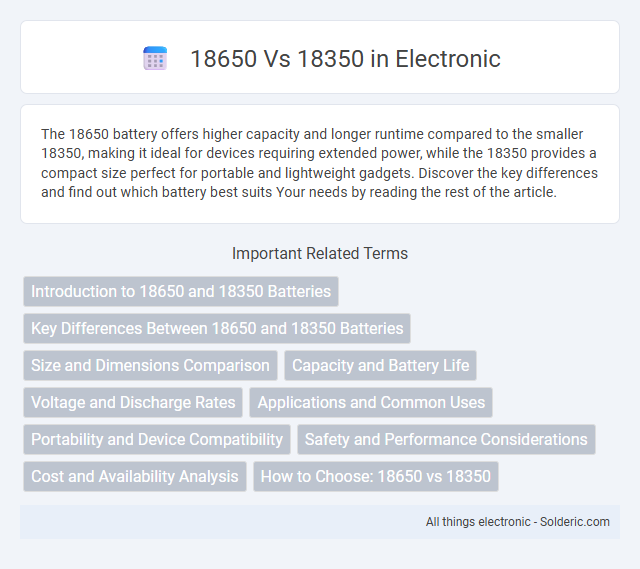The 18650 battery offers higher capacity and longer runtime compared to the smaller 18350, making it ideal for devices requiring extended power, while the 18350 provides a compact size perfect for portable and lightweight gadgets. Discover the key differences and find out which battery best suits Your needs by reading the rest of the article.
Comparison Table
| Feature | 18650 Battery | 18350 Battery |
|---|---|---|
| Dimensions | 18mm diameter x 65mm length | 18mm diameter x 35mm length |
| Capacity | 1800mAh - 3500mAh | 700mAh - 1200mAh |
| Voltage | 3.6V - 3.7V nominal | 3.6V - 3.7V nominal |
| Weight | 40g - 50g | 20g - 25g |
| Usage | High-capacity devices, laptops, power tools, flashlights | Compact devices, tactical lights, vape pens |
| Discharge Rate | Up to 20A continuous | Up to 10A continuous |
Introduction to 18650 and 18350 Batteries
18650 and 18350 batteries are popular lithium-ion rechargeable cells widely used in electronic devices, with the main difference being their size and capacity. The 18650 battery measures 18mm in diameter and 65mm in length, offering higher capacity and longer battery life, making it ideal for laptops, flashlights, and electric vehicles. The smaller 18350 battery, at 18mm by 35mm, suits compact devices where space constraints require a more compact power source, providing portability without sacrificing reliable energy output.
Key Differences Between 18650 and 18350 Batteries
18650 batteries have a larger capacity and higher voltage output compared to 18350 batteries, making them suitable for devices requiring longer run times and more power. The 18350 is more compact and lighter, ideal for smaller gadgets or where portability is a priority. Your choice depends on balancing size constraints against performance needs, with the 18650 favored for energy-intensive applications and the 18350 for compact designs.
Size and Dimensions Comparison
The 18650 battery measures 18mm in diameter and 65mm in length, while the 18350 battery is smaller, with an 18mm diameter and 35mm length. This size difference affects their capacity and device compatibility, making 18650 batteries ideal for high-capacity power needs and longer usage. Your choice between these two depends on the device's size constraints and power requirements.
Capacity and Battery Life
The 18650 battery typically offers a higher capacity, ranging from 1800mAh to 3500mAh, resulting in longer battery life compared to the smaller 18350, which usually has capacities between 700mAh and 1200mAh. This significant difference in capacity allows devices powered by 18650 batteries to run for extended periods before requiring a recharge. Users requiring compact size and portability may opt for 18350 batteries, but this comes at the cost of reduced battery life.
Voltage and Discharge Rates
18650 batteries typically offer a nominal voltage of 3.7V with discharge rates ranging from 10A to 30A, making them suitable for high-drain devices. In contrast, 18350 batteries also have a nominal voltage of 3.7V but generally feature lower discharge rates, around 5A to 15A, due to their smaller size and capacity. The higher discharge rate and capacity of 18650 cells provide longer runtime and better performance in power-intensive applications.
Applications and Common Uses
18650 batteries are widely used in high-drain devices such as laptops, flashlights, and electric vehicles due to their higher capacity and longer runtime. In contrast, 18350 batteries are preferred in compact devices like portable vaporizers, small flashlights, and handheld electronics where size constraints are critical. Both battery types are lithium-ion and offer rechargeable convenience, but their applications are dictated primarily by size and power requirements.
Portability and Device Compatibility
The 18650 battery offers a larger capacity and longer runtime, making it suitable for high-drain devices like laptops and flashlights but sacrifices portability due to its larger size. The 18350 battery is more compact and lightweight, ideal for smaller devices such as compact flashlights and vape mods, ensuring better portability without significantly compromising performance. Device compatibility depends heavily on the battery size and voltage requirements, with 18650 cells fitting devices designed for longer use, while 18350 cells accommodate smaller, more portable gadgets.
Safety and Performance Considerations
The 18650 battery offers higher capacity and sustained current output, enhancing performance for devices requiring longer runtime and consistent power delivery. The 18350 battery, being smaller, has a lower capacity and discharge rate, making it suitable for compact devices but with more frequent charging cycles. Safety considerations include using the correct charger and avoiding over-discharge; the larger 18650 cells often include built-in protection circuits, whereas many 18350 cells require external protection, increasing the importance of careful handling.
Cost and Availability Analysis
18650 batteries generally offer better cost-efficiency due to their widespread use in laptops, power tools, and electric vehicles, resulting in lower prices and higher availability compared to the smaller 18350 cells. 18350 batteries tend to have higher costs and limited availability because they are specialized for compact devices such as vape mods and flashlights. Your choice should consider budget constraints and device compatibility, as 18650 packs more energy per dollar and is easier to find in the market.
How to Choose: 18650 vs 18350
Choosing between 18650 and 18350 batteries depends on your device's power requirements and size constraints; 18650 cells offer higher capacity and longer runtimes, making them ideal for high-drain devices, whereas 18350 batteries provide a compact form factor perfect for smaller gadgets. Consider your device's voltage and current needs, as 18650 batteries typically deliver more consistent power output, enhancing performance and efficiency. For your optimal choice, evaluate battery capacity, physical size, and compatibility to ensure safety and maximize device functionality.
18650 vs 18350 Infographic

 solderic.com
solderic.com